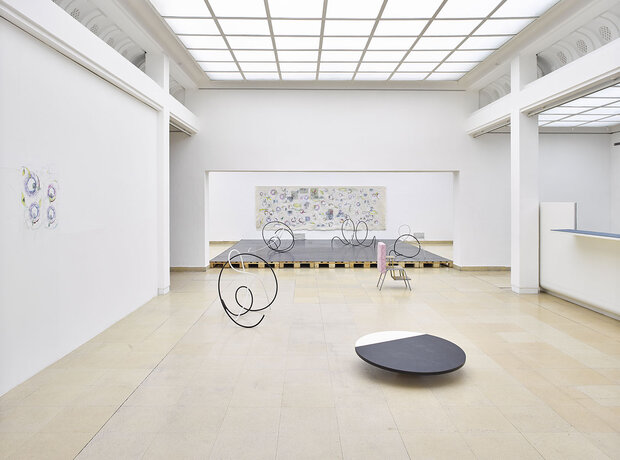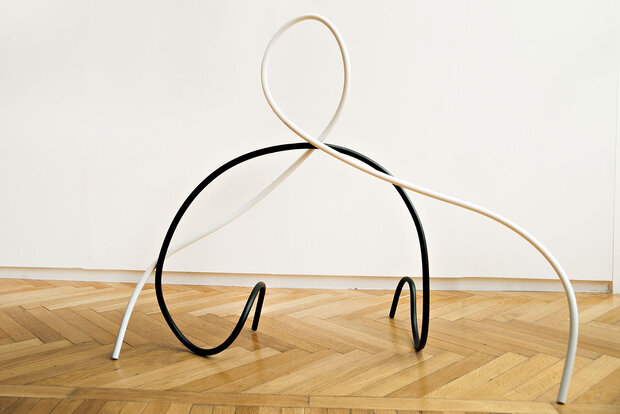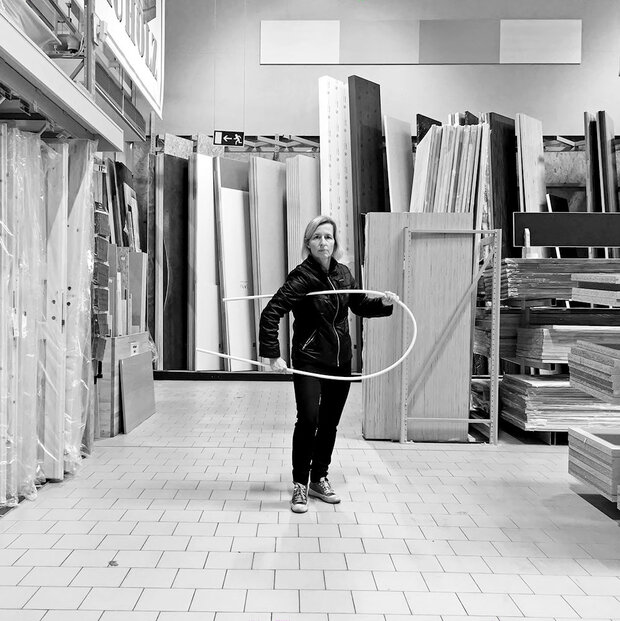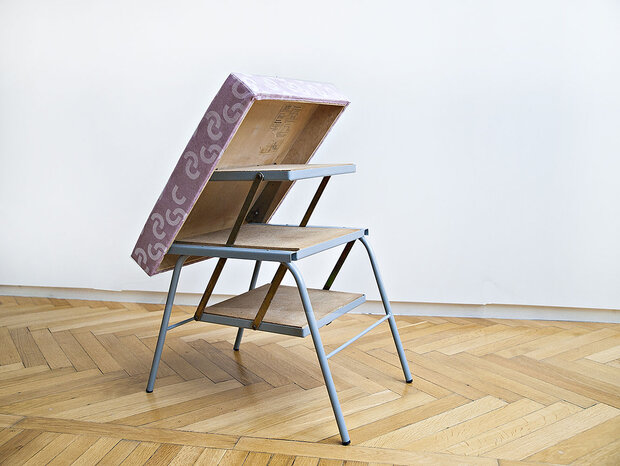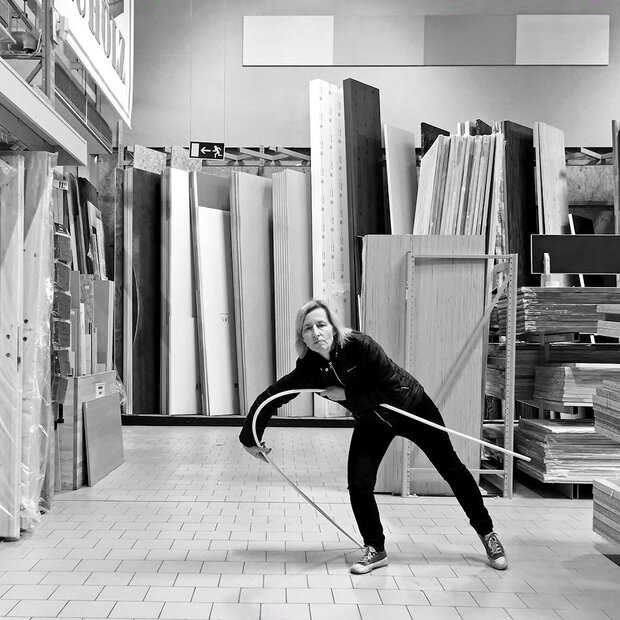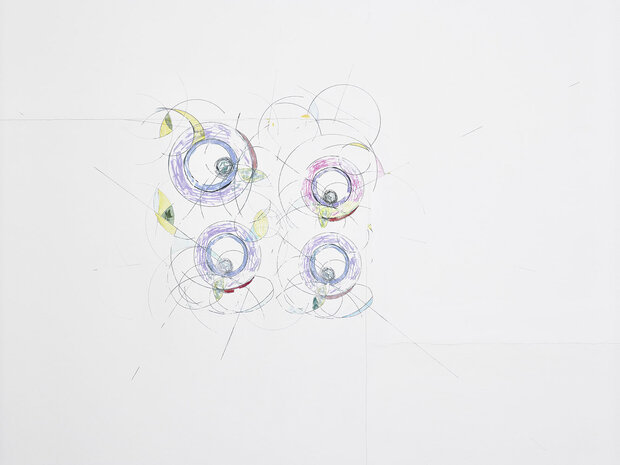FELDENKREIS_F1_001
2017
For the exhibition Felden_kreis FI_001, Carola Dertnig starts out from a private Feldenkrais archive, in which movements have been transposed into language, and then develops a translation back into movement and turns. In the Kunstpavillon she creates a performative setting investigating patterns of movement, and reflects on these in the light of art and performance history in the 20th and 21st centuries.
Carola Dertnig lays out a field of experiment between avantgarde and do-it-yourself store, between Bauhaus and B&Q, which she occupies and handles thoroughly and with obvious enjoyment.
The Feldenkrais method examines the logic of movements from various perspectives. Moshé Feldenkrais was a passionate researcher. As an engineer, physicist and judo master, after a knee injury he systematically investigated the learning process through the example of his own body. Group sessions within the Feldenkrais method are known as "Awareness through movement". Individual teaching serves "functional integration", during which patterns of movement and behaviour are examined.
It rapidly becomes clear upon entering the gallery, from the objects placed in the front space, that Carola Dertnig's solo presentation in the Kunstpavillon is about movement and the relations between object, space and man himself: a large balance board, a sculpture generating a dynamic impression - made from interlocking white and black, metal composite pipes - and a small, hybrid item of furniture, something between a stool and a step ladder. She refers to the object CD_KMH, 2017 as a "ready made appropriation restoration". The folding household stool "Karl Marx" was once the epitome of functional GDR design. Rather than covering it, as it was originally, with wipe-clean artificial leather, Carola Dertnig has used velour, which she has had printed with the interlocking initials "CD" beforehand. Associations with various luxury labels are not unintentional. The found, revitalized folding stool is linked to Carola Dertnig's interest in small mobile stages. In earlier performances she already employed speaker's platforms, which she based on a 1920s design by Russian constructivist Alexander Rodchenko for a workers' club.
By contrast to the smallest podium, the CD_KMH, the stage sculpture in the rear space of the Kunstpavillon is space-consuming, and framed by a 4.5 metre wide stage drop. The dance notations applied to canvas by means of photo transfer and drawing refer to both the US-American dancer, choreographer and performance artist Trisha Brown and to developments in contemporary dance during the 1920s and 30s. These notations have been translated into the artist's own movements. The stage set Felden_kreis_AM shows drawings of movement evolving from movement. The photo series Felden_kreis FI_001_010 indicates that the black and white pipe sculptures occupying part of the stage are also studies of movement. Carola Dertnig performs in the do-it-yourself store using metal composite pipes and records herself in the process. As framed fine art prints she brings the do-it-yourself store action closer to the Bauhaus once again, where design history was written with the introduction of steel pipes into furniture construction in the 1920s and 30s. It is no coincidence, therefore, if we are reminded of cantilever chairs when viewing the hand-bent sculptures Felden_kreis_AM.
In the side wing, Carola Dertnig is showing the performance video … an exile …, recorded in Tiflis, Georgia, in 2013/2014. It was presented for the first time in 2017. In it, the artist is walking down a set of steps in the old city. She is wearing a badly knitted coat, which is unravelling gradually and so leaving a track along her previous path. The red thread stretches down the bending flight of steps like a demarcation line, and the people she encounters react in different ways: despite some reservations, women attempt to tell the performer about her "mishap"; men act as though the thread did not exist, but noneless, they are compelled to step over it. Having arrived at the foot of the steps, we see a square extending towards a post-modern bridge. The square seems to be a meeting place for - predominantly young - people, who deal with the situation in a more offensive way and even begin to play with the thread after the performer has rid herself of the item of clothing - now consisting of no more than the shoulder piece - and disappeared over the bridge. While she is crossing the square, a passage of text is spoken from the Off, a sample from the essay Shadow Cities by André Aciman:
An exile reads memory, an exile reads love, an exile reads fear, an exile reads beauty, an exile reads food and drinks, an exile reads change the way one reads time. An exile is not just someone who has forgotten his or her home, an exile is someone who cannot find another, who cannot think of another home, someone who does not longer know what home means. An exile is someone who reinvents the concept of love with what is left. What does it mean to be an exile? When does it go away? How does it reinvent one? Does it ever go away? An exile reads change the way one reads time. An exile reads change the way one reads time, who reinvents the concept of love.
Four years ago it was prevalent already to talk about mechanisms of social inclusion and exclusion, about cultural differences and the dominance of the western world. In the meantime – a refugeee catastrophe later, which has led to a divided society in Central Europe due to the fear of strangers often fueled further by nationalist populists – the video is charged with yet more meaning. … an exile … makes clear that "Awareness through movement" is not only a body-oriented learning method for self-awareness based on Feldenkrais; it may also be termed a performative strategy.
Ingeborg Erhart
